Once upon a time there was Methodist Pastor who was appointed to a modest Methodist church in a very small town.
In his first week, the Pastor needed a haircut, and there was only one barber in town. The town was so small that the one barber also happened to be the pastor of the one Baptist church in the little town.
“Great!”, he thought. “I’ll get to know my fellow coworker in the Lord!”
He went to the Baptist barber shop for his haircut, and after hitting it off right away, the Baptist preacher asked the Methodist Pastor if he wanted a shave.
“Sure! That sounds great!,” the Methodist Pastor responded, being as diplomatic and hospitable as possible as a new-comer.
“Just know that my wife does the shaves. She’s so much better at it than me. She’s got a still hand.”
He then called out to his wife who was in the back room, “Grace! Come meet the new Methodist Pastor!”
They met. It was great. Lovely lady.
She gave him a great shave, and after parting greetings, the day moved on.
The next day, the Methodist pastor woke up and noticed immediately…no stubble. His tight shave from the day before was as fresh as it was many hours ago.
He shrugged it off. No big deal.
By the end of the same day, however, still no stubble.
He began to wonder what was going on.
Stress of the new job, perhaps?
The next morning, still no facial hair growth. No five-o-clock shadow. Nothing whatsoever. Perfectly, clean shaved as two days before.
Befuddled, he decided to go back to the barber shop to inquire.
“Preacher!”, said the Methodist Pastor, “Help me understand something. I have absolutely NO hair growth after my shave two days ago! What’s going on?!”
With a huge smile on his face, the Baptist Preacher said, “Friend, don’t you know? Once shaved by grace, always shaved by grace.”
Historically, there are two dividing lines between Protestant denominations: (1) differences in opinion on church governance structure (i.e., “polity”), and (2) theological differences.
In the weeks and months to come, Wellspring Church will be starting the very important, decision-making process regarding denominational affiliation. In prayerful preparation for that process, I will be dedicating significant teaching time (including this weekly “devotional” and Thursday nights) to discussing the historical and theological distinctions of “Methodism”, and—more broadly—Wesleyan-Arminianism, so that the church as a whole is in a strong position to make an informed decision.
Yes, it is crucial that we affiliate with a denomination that is aligned with our values and mission at the level of governance (e.g., no trust clause, accountability for bishops, no guaranteed appointment of pastors, reasonable apportionments, breadth of authority for local church governance, etc.).
It is equally important that we affiliate with a denomination with whom we are aligned theologically.
As you know, the theological spectrum of what constitutes as “Methodist” is massive. When meeting someone new and they ask me what kind of church I pastor, I answer “Methodist”, but then I have to go on and explain what kind of “methodist” I am NOT. “Methodist” means so many things to so many people precisely because the spectrum of theological difference is so big.
That magnitude of the theological variety within the name “Methodism” is represented in by the shear number of methodist denominations that exist (click here for more).
With this background, it is absolutely essential that as a congregation we are relatively familiar with the theological distinctions within Methodism. My goal is tto facilitate discussion and offer teaching and other resources on this particular topic so that our prayerful decision is as informed as possible.
To that end, I hope to answer questions such as:
- What does it mean to be “Methodist”?
- How is Methodism different from other Protestant denominations (e.g., Baptist, Presbyterians, Pentecostals, etc.)?
- What does “Wesleyan-Arminian” mean?
- What is “entire sanctification”?
- How is the Wesleyan understanding of sanctification different than other groups?
- What is the difference between American holiness theology and British holiness theology?
- What are the differences between the “short”, “middle”, and “long” ways of entire sanctification?
- Why do Methodist practice infant baptism?
- How is the Methodist understanding of grace and sin different than other Christian groups?
- What are the theological commonalities and differences between the methodist denominations that we are considering as a church?
Furthermore, starting on May 9th, we will shift the focus of our Thursday night Bible study from Psalms to Wesleyan-Arminian theology.
In the meantime, I’m including here a list of trusted resources on this topic.
Please be praying with me that the Holy Spirit would guide us as we approach this topic with humility, seeking to do God’s will for the church together!




